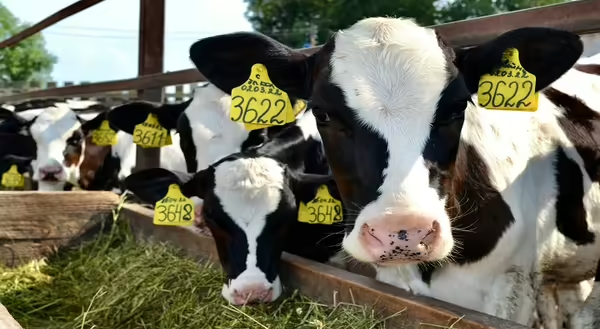
Growing up, my family raised Holstein cattle, which my siblings and I have grown to love. Although this is a well-known dairy breed, my family did not raise Holsteins for milk; instead, my father raised bull calves from a few days old up to slaughter weight for beef production.
Most of the fields in Illinois are filled with crops, but cattle also play a significant role in the state’s agriculture. According to the USDA National Agricultural Statistics Service, Illinois had approximately 1,000,000 head of cattle and calves in 2023. Among that number, they estimate 79,000 of Illinois’ cows are milk cows, with 3,900 of those cows located in McLean County. With summer approaching, we can expect to see various breeds of dairy cattle at the upcoming 4-H shows, such as Ayrshire, Jersey, Guernsey, Holstein, Milking Shorthorn, and Brown Swiss. Let's take the opportunity to explore more about each breed and how milk is processed.
Dairy Breeds
The Ayrshire cattle originated in Ayr County, Scotland, and were imported to Connecticut in 1822. They are excellent grazers and are known for their well-developed udder structure, which enables them to produce high quantities of milk while being raised in pastures. Ayrshire milk is utilized for making both butter and cheese.
The Jersey cattle breed is one of the smallest dairy breeds, originating from the Island of Jersey in England and arriving in the United States in the 1850s. The average Jersey cow weighs only 900 pounds but can produce as much as 13 times her body weight in milk each time she calves. Historically, there were two types of Jerseys – the Island and the American. The two were bred for different reasons, but that distinction is not emphasized today. The Island Jerseys were bred for their beauty and structure, making them appealing in the show ring, while the American Jerseys were bred to be larger in size for the production of butterfat and milk. Today, their milk is very flavorful due to the high butterfat content.
The Guernsey cattle originated from the Island of Guernsey in England and were imported to New York in 1840. Due to their light reddish-brown color mixed with white, this breed is more suitable for warmer climates than darker-coated breeds. These cattle often mature at a faster rate than other breeds, allowing them to be bred, have a calf, and produce milk at a younger age. Guernsey milk is often golden in color because it is high in beta-carotene content, which is a pigment color producer that our bodies turn into vitamin A.
The Holstein cattle originated in the Netherlands and were imported to Massachusetts in 1852. They are known for their high milk production, although the protein and butterfat levels in the milk are lower compared to other breeds. This breed is the most widespread in the United States for dairy production.
Milking Shorthorn cattle were first imported from England to Virginia in the United States in 1783. This breed was frequently bred to meet the practical needs of farmers for meat and milk, and their power was used as a means of transportation. This led to the development of two types of Shorthorns. English shorthorns were bred by Englishmen and were known for their milk production. Scotch shorthorns were bred by a Scotchman and were known for being more muscular and meatier.
Brown Swiss cattle originated from the Swiss Alps Mountain ranges of Switzerland. They were raised in both the mountains and the pastures, which made them adaptable to various terrains and climates. These cattle were first brought to Massachusetts in 1869. The milk from this breed is highly desired by cheese producers because it has the best fat-to-protein ratio.
Milk on our Shelves
Cattle have played a significant role throughout history, both for their meat and milk. Do you know how milk is processed from the cow to the grocery store?
After a calf has been weaned from a cow, a farmer can collect raw milk from the cow by hand or by machine. The raw milk is then stored in a refrigerated tank before being processed. The milk goes through several processes to create various products available in the market. First, the milk is purified, causing the butterfat to rise to the top as cream. Next, the milk is homogenized to ensure consistency. After homogenization, the milk undergoes pasteurization – in which it is heated to boiling to eliminate germs and then rapidly cooled. Whole milk contains all the cream, while skim milk has had the cream removed. The cream can be used to produce various products, including sour cream, butter, cottage cheese, cream cheese, yogurt, cheese, and ice cream. Finally, all the dairy products are packaged, sealed, dated, and refrigerated. Refrigerated trucks then transport these products to grocery stores for sale.
As you explore the county fairs this summer, keep an eye out for these dairy cattle breeds, and remember how milk gets to our shelves!
AUTHOR: Ashley Stockmaster, Agriculture and Natural Resources Intern